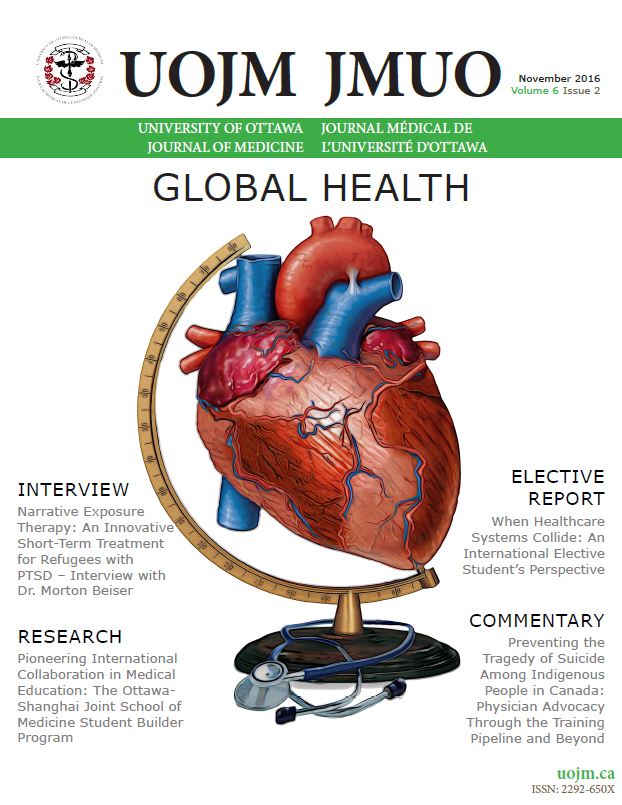Mind the Gap: Improving Pediatric Cancer Care in Developing Countries
DOI:
https://doi.org/10.18192/uojm.v6i2.1812Keywords:
Global healthAbstract
ABSTRACT
Despite the fact that the majority of childhood cancer cases occur in the developing world, pediatric oncology in developing countries has not been afforded the ground breaking advances and successes that are available in developed countries. It is an underestimated global child health concern, and the factors contributing to the two-tiered cancer outcome profile between developed and developing countries are complex and expansive. There are some initiatives in place, such as the twinning program, that are successfully improving cancer treatment in resource-limited regions, but more international advocacy is needed to make state of the art cancer therapy available to all children.
RÉSUMÉ
Bien que la majorité des cas de cancers pédiatriques se produisent dans des pays en voie de développement, l’oncologie pédiatrique dans ces pays n’a pas pu profiter des avancées révolutionnaires qui sont accessibles dans les pays développés. Cela est un problème de santé pédiatrique mondiale sous-estimé, et les facteurs contribuant au profil à deux paliers des taux de survie du cancer entre les pays développés et ceux en voie de développement sont complexes et de grande ampleur. Il y a des initiatives en place, tels les programmes de jumelage, qui améliorent avec succès le traitement du cancer dans les régions possédant des ressources limitées, mais plus de défense internationale des droits des enfants est nécessaire pour assurer la disponibilité des toutes dernières thérapies contre le cancer pour tous les enfants.
References
2. Magrath I, Steliarova-Foucher S, Epelman S, et al. Pediatric cancer in low-income and middle-income countries. Lancet Oncol. 2013;14(3):e104-e116.
3. Ellison L, Pogany L, Mery L. Childhood and adolescent cancer survival: a period analysis of data from the Canadian Cancer Registry. Eur J Cancer. 2007;43(13):1967-1975.
4. Rodriguez-Galindo C, Friedrich P, Morrissey L, et al. Global challenges in pe¬diatric oncology. Curr Opin Pediatr. 2013;25(1):3-15.
5. Chantada G, Qaddoumi I, Canturk S, et al. Strategies to manage retinoblas¬toma in developing countries. Pediatr Blood Cancer. 2010;56(3):341-348.
6. Leander C, Fu L, Pena A, et al. Impact of an education program on late diag¬nosis of retinoblastoma in Honduras. Pediatr Blood Cancer. 2006;49(6):817- 819.
7. De Angelis C, Pacheco C, Lucchini G, et al. The experience in Nicaragua: childhood leukemia in low income countries – the main cause of late diag¬nosis may be “medical delay”. Int J Pediatr. 2012.
8. Arora R, Eden T, Pizer B. The problem of treatment abandonment in children from developing countries with cancer. Pediatr Blood Cancer. 2007;49(7):941-946.
9. Friedrich P, Lam C, Itriago E, et al. Magnitude of treatment abandonment in childhood cancer. PLOS One. 2015;10(9):e0135230.
10. Metzger M, Howard S, Fu L, et al. Outcome of childhood acute lymphoblas¬tic leukaemia in resource-poor countries. Lancet. 2003;362(9385):706-708.
11. Sala A, Pencharz P, Barr R. Children, cancer, and nutrition – a dynamic tri¬angle in review. Cancer 2004;100(4):677-687.
12. Sala A, Rossi E, Antillon F, et al. Nutritional status at diagnosis is related to clinical outcomes in children and adolescents with cancer: a perspective from Central America. Eur J Cancer. 2012;48(2):243-252.
13. Antillon F, Rossi M, Molina A, et al. Nutritional status of children during treatment for acute lymphoblastic leukemia in Guatemala. Pediatr Blood Cancer. 2012;60(6):911-915.
14. World Health Organization. Blood safety and availability. [Last modified: July 2016]. [Cited August 29, 2016]. Available from http://www.who.int/media-centre/factsheets/fs279/en/.
15. Shad A, Ashraf M, Hafeez H. Development of palliative-care services in a developing country: Pakistan. J Pediatr Hematol Oncol. 2011;33:S62-S63.
16. White Y, Castle V, Haig A. Pediatric oncology in developing countries: chal¬lenges and solutions. J Pediatr. 2013;162(6):1090-1091.
17. Qaddoumi I, Musharbash A, Elayyan M, et al. Closing the survival gap: implementation of medulloblastoma protocols in a low-income country through a twinning program. Int J Cancer. 2008;122(6):1203-1206.
18. Mostert S, Sitaresmi N, Gundy C, et al. Comparing childhood leukemia be¬fore and after the introduction of a parental education programme in Indo¬nesia. Arch Dis Child. 2010;95:20-25.
19. Gupta S, Rivera-Luna R, Ribeiro R, et al. Pediatric oncology as the next global child health priority: the need for national childhood cancer strategies in low- and middle-income countries. PLOS Medicine. 2014;11(6):e1001656.
20. London W, Moroz V, Hero B, et al. A neuroblastoma risk classification model for developing countries: a study from the international neuroblastoma risk group database. Pediatr Blood Cancer. 2014;61(S2):S119.
21. Ferlay J, Shin H, Bray F, et al. Estimates of worldwide burden of cancer in 2008: GLOBOCAN 2008. Int J Cancer. 2010;127(12):2893-2917.
Downloads
Published
Issue
Section
License
- Authors publishing in the UOJM retain copyright of their articles, including all the drafts and the final published version in the journal.
- While UOJM does not retain any rights to the articles submitted, by agreeing to publish in UOJM, authors are granting the journal right of first publication and distribution rights of their articles.
- Authors are free to submit their works to other publications, including journals, institutional repositories or books, with an acknowledgment of its initial publication in UOJM.
- Copies of UOJM are distributed both in print and online, and all materials will be publicly available online. The journal holds no legal responsibility as to how these materials will be used by the public.
- Please ensure that all authors, co-authors and investigators have read and agree to these terms.
- Works are licensed under a Creative Commons Attribution-NonCommercial-NoDerivatives 4.0 International License.


